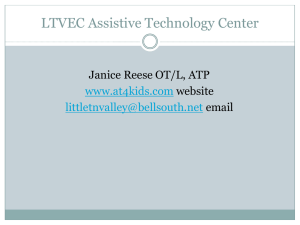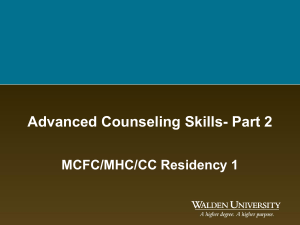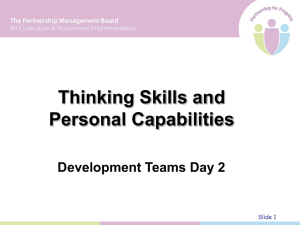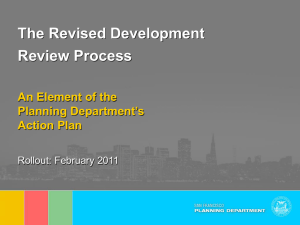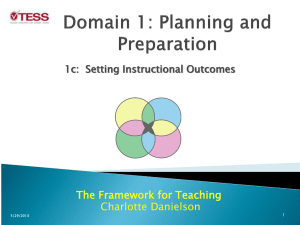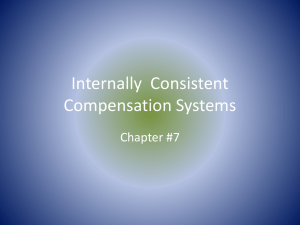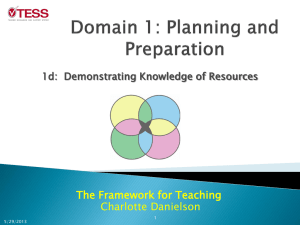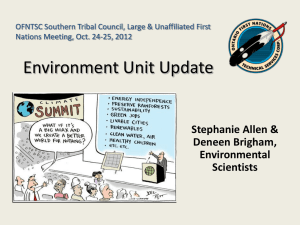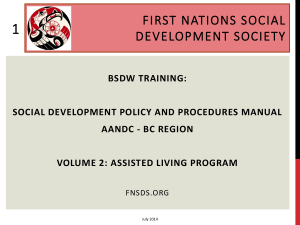AANDC ASSISTED LIVING PROGRAMS
advertisement
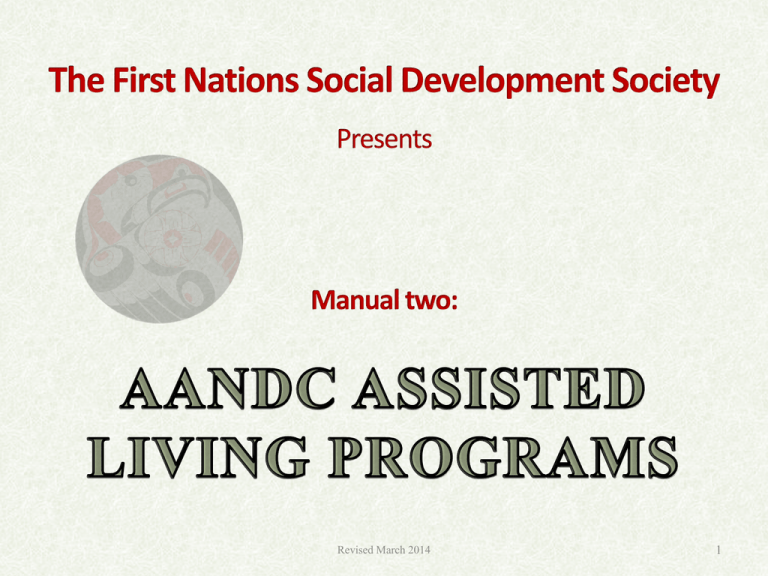
Revised March 2014 1 What can be found on our website www.FNSDS.org? The FNSD Resource Centre Library The Online SA Manual Downloadable and fillable IA Forms Board Info, BSDW & INAC contact lists Publications FNSDS Newsletters and job postings BSDW Training Info Training Programs Information, calendar and registration information Power point presentations PWD & MNS Program Information, Forms, Q’s and A’s Revised March 2014 2 CONTACT INFORMATION PHONE: 604-983-9820 FAX: 604-983-9822 Melennia Point, Executive Director Gina George, PWD Manager PWD line Tami Omeasoo, Program Officer Chris Lechkobit, Program Officer Chelsey George Melennia@fnsds.org Gina@fnsds.org 1-877-985-5565 Tami@fnsds.org Chris@fnsds.org Pwdadminasst@fnsds.org Revised March 2014 3 NON- MEDICAL SERVICE PROGRAMS 1 – Adult in Home Care 2 – Adult Institutional Care 3 – Family Care Home Revised March 2014 4 AANDC NATIONAL MANUAL ASSISTED LIVING PROGRAM (AL) Funded program to provide social support services to persons living on reserve that require non-medical assistance with daily living activities 1. Main Objective and Program Description 1.1 Funding to meet the non-medical social support services special needs of seniors, adult with chronic illness and children and adults with disabilities (mental or physical) with the objective of maintaining functional independence and greater self-reliance. 1.2 AL program is available to all persons residing on reserve or are considered ordinary residence that have been assessed by medical physician to require non-medical social support services and who have no means to otherwise obtain these services. Revised March 2014 5 3.1 FOUR MAJOR SERVICE COMPONENTS 1. In-Home Care – financial assistance for non-medical personal care for adults that need assistance with daily living activities. Services cover housekeeping, meal preparation and attendant care to community supports (adult care, meals on wheels, physic-social programs, short-term respite care for caregivers and non-health transportation). 2. Adult Foster Care – funding for supervision and care for adults in a family-like setting who do not require 24 hour care but are unable to live on their own. 3. Institutional Care – reimburses for some expenses related to Type I and II care in designated facilities for adults. 4. Assisted Living Disabilities Initiative – funding to First Nation organizations for projects to improve the coordination and accessibility of existing disability programs and services on reserve. May include advocacy, public awareness or regional workshops. Revised March 2014 6 2.1 ASSISTED LIVING PROGRAM DEFINITIONS 2.1.1 Continuing Care – range of holistic medical and social support services for those who do not have, or who have lost some capacity to care for themselves . 2.1.2 Disabilities Initiative – AANDC initiative to fund projects to improve coordination and accessibility of existing disability programs and services on reserve such as advocacy, public awareness or regional workshop 2.1.3 Home Support – component of AL program that provides homemaker services to help persons with daily living activities so they can remain at home and remain independent 2.1.4 Institutional Care – care provided in a care facility such as a personal care home, elders lodge and supportive living home etc. Revised March 2014 7 ORDINARY RESIDENT ON RESERVE Lives at permanent address on-reserve more than 50% of time In case of children in joint custody, lives with parent more than 50% of time Does not have a primary residence off-reserve Is a person off-reserve for purpose of obtaining care not available on reserve or who is off-reserve to access social services because there is no reasonable comparable service available on-reserve Revised March 2014 8 Revised March 2014 9 INTENTION Assist clients to live at home as long as it is reasonable and safe Supplement care, NOT to replace care provided by family or other unpaid caregivers Promote independence and well-being of a client and their family and other unpaid caregivers Provide short term respite care to family member or other unpaid caregiver Revised March 2014 10 PHILOSOPHY Promote personal independence Promote personal and family responsibility in planning and providing care Encourage family and community involvement in providing care Encourage lifestyle consistent with community norms Work in partnership with other complementary programs and services offered by other federal government departments. Example: Veteran's Affairs, Health Canada First Nation & Inuit Home And Community Care Program Revised March 2014 11 NATIONAL ELIGIBLE EXPENSES 3.1 In-Home Care provides financial assistance for non-medical personal care services. Services may include (dependent on budget) Meal programs, meal planning & preparation Day programs Attendant care short-term respite care (defined by Province/Territory) group care laundry ironing mending carrying water carrying wood home management minor home repairs non-medical transportation guide dogs Revised March 2014 12 ELIGIBILITY AND FUNDING Capped Funding Once funds finished no more remain for fiscal year Eligibility Client must be 19 or older Must be assessed (medical note is best) Financial means test required (income tax forms) IA clients = no charge Pensioner receiving Old Age Security = no charge Revised March 2014 13 PROCESS 8. Every 6 months BSDW reviews application and may go through steps 1 to 7 if necessary 1. Request for services 2. BSDW has applicant fill in the Application for Homemaker Services (901-38)file open 7. BSDW & applicant complete part IV of Application for Homemaker Services (90138) 6. BSDW completes part III of Application for Homemaker Services (90138). 3. BSDW contacts an assessor to help determine care requirements 5. BSDW and Assessor review application and make decision Revised March 2014 4. Assessor does home visit- checks to see if anyone in family/community can assist 14 FILES Identification Medical request letter Income Tax Statement Homemaker Service form 901-38 signed and dated Homemaker Evaluation form 901-30 signed and dated Blank cover In Home Care Tracking Payments form 901-31 Homemakers schedule Case notes Copies of all correspondence to client Do create a system to help remind you when review is due Revised March 2014 15 ROLES DEFINED BSDW ASSESSOR Monitor budget Report expenses on quarterly report Monitor and approve hours (do max at 40 per month- anymore hours required = need to look at care in a Institutional Care facility) Ensure files are complete Monitor homemakers hours Keep case notes on file Do reviews every 6 months Meet with BSDW for information Set up home visit Assess who in family or community can provide assistance and care Complete Homemaker Evaluation form 901-30 Meet with BSDW to determine eligibility and services Repeat process every 6 months Revised March 2014 16 BILLING Do create a set charge for service Helps with report Assist in determining hours available each month to helps stay within budget keep in mind must cover wages, MERC, travel and supplies Must pay workers at least minimum wage ($10.50 per hour) Report spending on Assisted Living Quarterly Report Revised March 2014 17 SERVICES AVAILABLE Light House Keeping (sweeping, mopping, vacuuming, clean & tidy kitchen and bathroom) Meals (preparing food by cutting up meat and peeling and dicing vegetables) Personal Care (cleaning & tidying bedroom, doing personal laundry, monitoring their bath and cleaning & tidying up bathroom) Other Services (travel to medical and/or specialist appointments) Revised March 2014 18 OTHER SUPPORT SERVICES Services limited to availability of budget and resources - Some ideas for programs: Counselling Meals (luncheon program) Psycho-social (socializing activities) Non-medical transportation Home maintenance (minor) Companion care Respite Care for caregivers Social Assessment & Case Management Services Coordination of volunteer & support group services Services to support councils for seniors &/or Persons With Disabilities Revised March 2014 19 PROCEDURE FOR OTHER SERVICES Contact AANDC Funding Service Officer to discuss reporting requirements which may include: Type of SD program or service to be established Number clients served Program Management structure Number hours per type of service Number & training of service providers Budget for respective program or service Indicators of comparability with provincial programs Client profile Fee structure & financial eligibility Revised March 2014 20 IDEAS TO ENHANCE SERVICES Create a follow-up letter confirming approved services and what are the rules for services (alcohol or drug consumption = no service that day; not home = no service that day) During home visits, do allow time to visit and socialize Create a list for homemaker describing services to provide and any instructions client may have requested Create a notice card you can hang on door to let client know worker was there but they were not home Create a notice for times when service my be temporarily stopped due to holidays or sickness Revised March 2014 21 SORRY WE WILL BE CLOSED Sorry we missed you. Homemaker _____________ was here at _____________. No one was home at that time. we will return at your next appointment. Due to statutory holiday on _________, office will be closed and services will be cancelled that day. We will reopen on _________ . Please call so we at the Adult In Home Care Program can set up another time to ensure your needs are met. Sincerely Take care Revised March 2014 22 Revised March 2014 23 INTENTION To assist eligible residents living on reserve, who by reason of incapacity, require placement in a licensed Continuing Care Facility To provide services appropriate to the eligible resident’s long-term functional needs Revised March 2014 24 ELIGIBILITY Must be 19 years or older Canadian citizen Have permanent resident authorization Last residence before care was on reserve (this determines the jurisdiction responsible for client no matter where care facility located) Unable to live independently because of on going health problems Cannot be in an acute or rehabilitative program Health-related issues should be: At least 3 months Due to progressive and/or chronic condition Revised March 2014 25 NOT ELIGIBLE & EXEMPTIONS Person who is sponsored to be in Canada 65+ and receiving a pension Exemptions: IA client or IA PWD earned income applies No other sources available, may sign up for Community Volunteer Supplement In Continuing Special Care facility can receive Comfort Allowance Revised March 2014 26 PROCESS 1 2 3 4 5 6 7 8 • Referral made • BSDW opens case file • Applicant completes Medical Release & Report form SA 115 • Request local health authority`s Home & Community Care Manager to do assessment • Assessor does home visit • Assessor makes recommendation for level of care • If required, assessor team will be established by local health authority • Placement in Continuing Care Facility approved, the Home & Community Care Case Manager does home visit & inform applicant Revised March 2014 27 9 10 11 12 13 14 15 • BSDW sends copy of Medical Release form SA115 to Home & Community Care Case Manager and requests copy of Applicant Assessment LTC 1 and Provincial Financial Profile & calculations HLTH 1.6 • Applicant unable to cover User Charges, BSDW will assess for Income Assistance • BSDW will request the Adult Institutional Care & Adult Family Care Home Client admission form be completed • BSDW will fax forms to AANDC FSO: AIC&AFCHCAF LTC 1 & Provincial FPC HLTH 1.6 • AANDC BC Region if form accepted, will send confirmation letter & state payment start date • BSDW keeps all required forms on file • BSDW will send in monthly financial information to AANDC & ensure client continues to meet eligibility requirements Revised March 2014 28 AANDC NATIONAL DEFINITION OF INSTITUTIONAL CARE LEVEL I &II AANDC has limited responsibility for non-medical Type I and II levels of 3.3.1 care Type I Independently mobile with decreased physical or mental facilities Requires supervision or assistance with activities of daily living and provision to meet psycho-social needs through social and recreational services Service requirements are indeterminate and related to individual conditions Normally would not be admitted to residential care facility Type II Relatively stabilized (physical or mental) chronic disease or functional disability Reached limit of recovery Require personal care on 24 hour basis with medical and professional nursing supervision for meeting psycho-social needs 3.3.2 Province and Territories responsible for licensing and monitoring facilities 3.3.3 AANDC may fund per diem portion of institutional care on case by case basis. Client expected to pay Provincial or Territorial government established co-institutional fees, clothing and personal expenses to extent they can financially afford Revised March 2014 29 AANDC NATIONAL ELIGIBILITY 3.3.4 Eligibility Requirements for Institutional Care – may be reimbursed, eligible recipients must verify care facility can demonstrate that: Operates according to licensing and /or recognition or accreditation guidelines of relevant provincial and territory Care services which care facility is invoicing do not exceed Types I and II levels of care 3.3.5 Eligible Institutional Care expenditures to be funded may include: standard accommodation meals; including therapeutic diets food Laundry clothing special diets guide dog necessary emergency & routine treatment supplies skilled care with professional supervision as needed & planned programs for social & recreational activities age allowance personal living allowance Revised March 2014 30 LEVEL OF CARE Personal Care Funding AANDC Able to stay at home, require some homemaking Intermediate Care Level 1(1C1) Funding AANDC Still independently mobile with or without mechanical aide Require moderate assistance with daily activities Require daily professional care and/or supervision Intermediate Care Level 2 (2C2) Funding AANDC Still independently mobile with or without mechanical aide Requires heavier care Requires heavier supervision and additional care time Intermediate Care Level 3 (3C3) Funding AANDC Severe behavioural problems on continuous basis or personal issues that require considerably more care and supervision Require considerably heavier care Not eligible for Extended Care Extended Care Level Funding Provincial /HCFNIH Chronic cases require 24 hour professional nursing services & continuing medical supervision Usually this level of care is permanent Revised March 2014 31 REVIEWS & ASSESSMENTS Taken at request of Client Service Provider Family member Physician Health Care Professional Request for reviews or reassessment goes directly to Home and Community Care Case Manager Revised March 2014 32 SERVICE DELIVERY ELIGIBLITY EXPENSES 4.1 Eligible funding - recipients who deliver the AL program receive additional resources to support the administration of the AL program 4.2 Eligible expenses to deliver AL program include Salaries Travel Transportation Training for professional or paraprofessional administrator and case workers related office costs activities related to collecting and managing data required program monitoring, planning, reporting and evaluation Revised March 2014 33 Maintaining and upgrading system Developing operational policy and related documents Developing delivery options to encourage local integration where possible of education, health and social services needed to effectively deliver and administer AL programs Developing and implementing case management systems including structured client assessment referral re-assessment and counselling training professional support for administration and case management * Out of Canada must be preapproved in writing by Director General Programs (AANDC) Revised March 2014 34 Revised March 2014 35 ADULT FOSTER CARE ELIGILBE EXPENDITURES Provides supervision and care in a family – like setting to people who cannot live on their own due to physical or psychological limitations but who do not need constant medical attention. This service is an alternative To institutional care. To be reimbursed for services adult foster care needs to 3.2.1 Conform to provincial or territorial per diem rates 3.2.2 Operate according to licencing and/or recognitions or accreditation guidelines of relevant province or territory. Revised March 2014 36 OBJECTIVE To provide a protective and supportive environment within a Private Family Home to eligible on-reserve elderly or disabled persons as an alternative to admission to a long term care institution. Revised March 2014 37 WHAT IS A FAMILY CARE HOME? Is a private family home that provides services to adults that require 24 hours supervision Is not normally the Client’s family home Located on-reserve Provides a home like atmosphere, meals and other housekeeping services. Within an atmosphere of a caring, supportive and assistive services with daily living activities to the elderly or disabled client Revised March 2014 38 ELIGIBLITY Must be a resident on-reserve at time of application Must be Canadian citizen, or authorized under Immigration Act to be a permanent resident of Canada Must be 19 years or older Assessed to need Residential Care by Continuing Care Division of Ministry of Health Revised March 2014 39 ROLES AND RESPONSIBILITIES DEFINED Administering Authority Approves Family Care Home based on screening information BSDW MOH-CCD Completes the Family Care Home Operator Approval Form (DK0201) and Adult Family Home Approval Checklist (DK02-02) Ensures Family Care Home Service Provider Agreement (DK02-04) is completed and signed Identifies eligible by home operator clients and matches client and Family Care Does ongoing Home operator monitoring of home Completes needs test, Collects the daily user monitors care of fee individual and services as link between client, Reimburses the home family and service provider operator based on submitted claims Provides assessment and establishes level of care for prospective client May assist to complete forms DK02-01 and DK02-02 AANDC Funding Services Directorates provided agreement to proceed with placement following approval of home by Administering Authority and based on available funds May assist with assessment of the compatibility of home and prospective client FSO provides reimbursement of per diem and associated charges based on submitted billing from May assist with ongoing appropriate monitoring, as Administering appropriate Authority Revised March 2014 40 CHECK LIST FOR HOME Fire safety Do consult with local fire authority BSDW needs to ensure presents of smoke alarms, fire extinguishers etc. Operator has a suitable fire evacuation plan Outdoor environment Yard safe for client - especially a wandering client No uneven surfaces Check for hazards such as ditches and wells General safety Check the floors, lighting and stairs to ensure in good repair General cleanliness Check for hygiene not just tidiness, especially kitchen and bathroom Living space Check to ensure space is adequate if client uses mechanical assistance to walk or a wheelchair 41 Revised March 2014 Adequate living area to accommodate clients needs CHECK LIST FOR HOME continued Basic nutrition, food preparation and meal planning Discuss with operator benefits of meal planning to assist Operator practices nutrition according to the Canada Food with evaluating their general knowledge and ability Guide/Native Food Guide regarding meals Wash and toilet facilities Clean and safe bathing and toilet facilities Is it near client’s bedroom for easy access and safety of client Bedroom Comfortably furnished single room Best on main floor- not acceptable to be in basement Room has a window, is warm, dry and well ventilated Furnishings Comfortable bed and adequate storage space Locked draw or alternative arrangement for clients valuables If possible, client able to use their own furnishings Insurance Operator must hold valid personal liability, fire, and automobile insurance Revised March 2014 42 ROLES FOR OPERATING HOME Administering Authority Operator Client Ensures operators of homes continue to provide high quality service Medication is in safe secure place and administered as instructed by pharmacist Visits home once a month Provides appropriate meals including therapeutic diet Ensure they have such personal care items as deodorant, toothpaste, talcum powder, hand lotion, denture cleaner, comb and brush, shampoo & conditioner and any special soap. Holds a crucial role in supporting and monitoring Family Care Home operator’s effectiveness as a care provider Responsible for own personal dry cleaning Diet supplements provided if needed by client Laundry service provided on a routine bases If a person reports suspecting that a home is putting client at risk, they can contact the Administering Authority who will take necessary steps to resolve situation General hygiene supplies provided for client as needed Responsible for personal phone, TV, newspapers, magazines, smokes, and transportation Responsible for any extra craft supplies and activities of personal hobbies Medical supplies are covered under health and operator is to ensure they are available as needed Incontinence care supplies and a routine set up to ensure client properly taken care of Physical, social and recreational activities are provided. Provides transportation to medical appointments, pick up prescriptions, shopping and recreational activities Revised March 2014 Exceptional transportation is to be preapproved by Administering Authority 43 RESTRICTIONS Pre-approved by Administering Authority for care of 1-2 clients 3 or 4 clients in home could result in home being closed Except where an extra client would as beneficial for both (and if home has room/ operator capable taking on extra capacity) Operator cannot be immediate family of client Exception to family rule: No qualified and available caregivers Rural or remote location Cultural barriers Language barriers Behavioural barriers Revised March 2014 44 RESPITE AANDC does special adjustment of $7.12 per resident per day to allow operator to purchase respite care up to 24 days per year. Operator still receives per diem rate when on respite therefore responsible for costs Approved respite care are In Home Respite – must have BSDW approval (not family member) Out of Home Respite – either licensed facility or another Family Care Home where the option available and suitable for client Respite Day Care – approved by Administering Authority and arranged by BDSW Revised March 2014 45 REPORT REQUIRED FOR RESPITE On form DK02-03 Adult Family Care Home Planned & Actual Respite Year end report to Administering Authority on respite taken and copy goes to AANDC Respite is 2 days per month when pro-rated One day = 24 hours Operators should take respite at a minimum of 1 day per month If the Operator is not using the respite allowance, they may have funds discontinued Revised March 2014 46 CLOSURE OF HOME PROCESS BSDW must notify Administering Authority immediately Administering Authority, Chief and Council are notified immediately and are in agreement then client is removed from home Administering Authority must notify AANDC Funding Service Officer of action taken Revised March 2014 47 SERVICE IS UNSATISFACTORY? BSDW must verbally advise operator of areas that must be improved Give a set time to comply Verbal Notice must be confirmed in writing within 2 days by BSDW BSDW must revisit home at end of specified time to ensure changes and service are satisfactory If found not satisfactory, BSDW must serve notice if situation not corrected, service may no longer be required Service remains unsatisfactory, BSDW must notify Administering Authority, who will verify findings If Administering Authority agrees with closure, operator is served 14 day written notice that services are terminated AANDC is to be notified immediately Revised March 2014 48 HEALTH CANADA’S FIRST NATION & INUIT HOME & COMMUNITY CARE (HCC) 5.1 General 5.1.1 AL program has close link to Health Canada’s HCC program which provides health services to eligible FN persons living on reserve and Inuit living in Inuit communities 5.1.2 HCC services are provided on comprehensive assessed needs and enable people with disabilities, chronic illnesses and elderly to receive care they need in their home communities 5.1.3 Both programs make up vital part of continuum care for FN persons. Services often begin in the home and progress through to more intensive levels of care normally associated with Institutional Care 5.1.4 The Social (non-medical) services funded by AL program support AANDC Child & Family services, Income Assistance, Special Education as well as the AL programs supports programs funded by other government departments (Health Canada) Provinces or Territories Revised March 2014 49 THREE MAIN AREAS OF HCC ARE Home Support – medical personal care (ex. Wound bandaging) Community Support – includes process evaluating how HCC programs are functioning Nursing – nursing care (ex. Administering medications) These include: Client Assessments & Care Planning Case Management Personal Care provided by trained personnel Home Nursing In-Home Respite System or process to assess medical equipment and supplies Program linkages with Health & Social Services both internal and external to community Client record & data system Revised March 2014 50 Thank you for your sharing and taking part in the workshop Have a safe trip home and please do contact the FNSDS or myself if you have any questions or concerns Take care Revised March 2014 51
